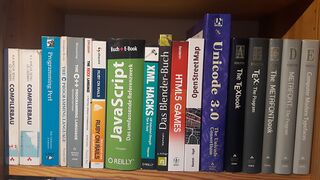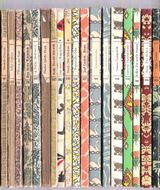SpineLib: Difference between revisions
Jump to navigation
Jump to search
imported>Gfis No edit summary |
imported>Gfis IM Hough lines |
||
| (One intermediate revision by the same user not shown) | |||
| Line 1: | Line 1: | ||
__NOTOC__ | |||
==Library Management Using Images of Book Spines== | ==Library Management Using Images of Book Spines== | ||
[[File:Bookshelf.jpg|320px|right]] | |||
[[File:2017-06-20 vert.jpg|160px|right]] | |||
Cataloging of the books a in private library with a few thousand books is much work, and usually it is not done. | Cataloging of the books a in private library with a few thousand books is much work, and usually it is not done. | ||
* ISBN barcode scanning could work in principle, but still each book must be taken from the shelf. Only newer books have ISBN barcodes. | * ISBN barcode scanning could work in principle, but still each book must be taken from the shelf. Only newer books have ISBN barcodes. | ||
| Line 11: | Line 12: | ||
* Such data are looked up in a big database for known books. | * Such data are looked up in a big database for known books. | ||
* Even if there is no exact match, the system could propose a small set of possible books, from which the librarian could select teh right book manually. | * Even if there is no exact match, the system could propose a small set of possible books, from which the librarian could select teh right book manually. | ||
An example of a catalogue with book spines is my [http://www.punctum.com/interest/inselbuch/insall.html collection of Insel Taschenbücher]. Slices where cut out of a scan like the second image on the right, but all segmentation information for a single book was measured manually. | |||
===Advantages=== | ===Advantages=== | ||
* Photographing of complete book shelves can be done rather easily and quickly in a large scale. | * Photographing of complete book shelves can be done rather easily and quickly in a large scale. | ||
* The system would be applicable to book stores for inventory purposes. | * The system would be applicable to book stores for inventory purposes. | ||
* Even public and university libraries could use it for protection against the misplacement of books in reading rooms. | * Even public and university libraries could use it for protection against the misplacement of books in reading rooms. | ||
===Problems=== | ===Problems=== | ||
* The book spine images are coyprighted by the publishers. | * The book spine images are coyprighted by the publishers. | ||
* OCR of the titles and authors will be difficult because of many different fonts and languages. | * OCR of the titles and authors will be difficult because of many different fonts and languages. | ||
===Intermediate Steps=== | |||
Implement some JavaScript functions which allow to manually | |||
* Shift distorted images in almost exact reactangular form. | |||
* Assign segmentation borders between books. | |||
* Determine the height of the book slice, and crop extra space. | |||
===ImageMagick=== | |||
* c.f. [https://www.imagemagick.org/discourse-server/viewtopic.php?f=4&t=25476 Hough line detector] | |||
Latest revision as of 08:49, 30 July 2018
Library Management Using Images of Book Spines


Cataloging of the books a in private library with a few thousand books is much work, and usually it is not done.
- ISBN barcode scanning could work in principle, but still each book must be taken from the shelf. Only newer books have ISBN barcodes.
- Google, Amazon and also community projects like LibraryThing provide images of book titles, but who is willing to photograph each book front?
Proposal
This project proposes the recognition of books from their spines.
- Photos from book shelves like the ones above are sliced into individual spine images.
- The images are analyzed for color zones, publisher logo, author and title text.
- Such data are looked up in a big database for known books.
- Even if there is no exact match, the system could propose a small set of possible books, from which the librarian could select teh right book manually.
An example of a catalogue with book spines is my collection of Insel Taschenbücher. Slices where cut out of a scan like the second image on the right, but all segmentation information for a single book was measured manually.
Advantages
- Photographing of complete book shelves can be done rather easily and quickly in a large scale.
- The system would be applicable to book stores for inventory purposes.
- Even public and university libraries could use it for protection against the misplacement of books in reading rooms.
Problems
- The book spine images are coyprighted by the publishers.
- OCR of the titles and authors will be difficult because of many different fonts and languages.
Intermediate Steps
Implement some JavaScript functions which allow to manually
- Shift distorted images in almost exact reactangular form.
- Assign segmentation borders between books.
- Determine the height of the book slice, and crop extra space.
ImageMagick
- c.f. Hough line detector